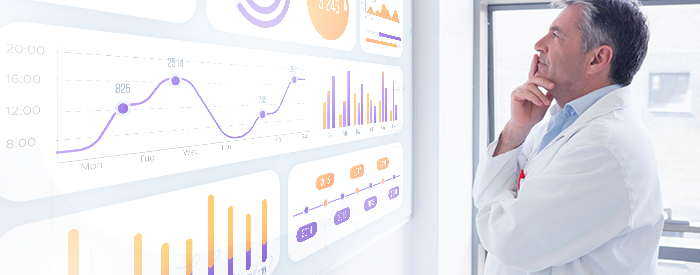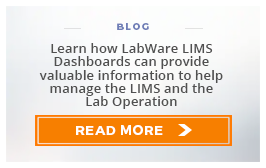Data Visualization: Make the Most of Your Lab Informatics
 You’ve probably seen the buzzwords data visualization, big data, and machine learning if you’ve been reading a lot in the last year or so. And who hasn’t been reading a lot during 2020—there’s not that much else to do! In this blog post, we’ll discuss some of the ways that data visualization tools can help you use accumulated data (even if it’s big data) to improve your bottom line and increase the perceived value of your laboratory informatics solutions.
You’ve probably seen the buzzwords data visualization, big data, and machine learning if you’ve been reading a lot in the last year or so. And who hasn’t been reading a lot during 2020—there’s not that much else to do! In this blog post, we’ll discuss some of the ways that data visualization tools can help you use accumulated data (even if it’s big data) to improve your bottom line and increase the perceived value of your laboratory informatics solutions.
Increasing numbers of companies are recognizing that their diverse workforces are better served by making data available in more than one form. Presenting the same information in a variety of ways increases the likelihood that it will be understood. The sheer volume of data that laboratories generate is a challenge to interpret, and often less intimidating in visual form.
Unfortunately, LIMS solutions have been traditionally underused with respect to their data and the formats in which it is displayed. Laboratory informatics have long been seen as data collection and storage vehicles, without much thought given to what to do with that data. Now, that is changing. Laboratories are beginning to see the value of looking at their data with data visualization tools.
Let’s start by examining how and why data visualization tools can be useful in identifying patterns and extracting insights from laboratory informatics data.
Identify Patterns With Data Visualization And Analysis
The data captured in a LIMS has the potential to show clear cycles or recurring events when displayed graphically through data visualization tools. Identifying these patterns allows labs to do better forecasting, such as with instrument use times, raw material evaluation, cycle times of products, samples processed per analyst, or even a manufacturing line that consistently results in out of spec product.
The ability to visualize large quantities of targeted laboratory data from a LIMS can help identify trends and issues that would normally be very difficult to identify in spreadsheets, lists, reports, or queries. In addition, leveraging data visualization to connect multiple sources of data (i.e., LIMS, ERP, MES) allows for cause-and-effect interpretation across manufacturing, supply chain, environmental, research and development, and quality.
These kinds of analytics help manage the restocking of consumables, reduce product losses, or, more important in these times, ensure appropriate staffing of the lab to abide by social distancing requirements. The end results of having this kind of information available are improvements in cost efficiency and optimal asset utilization.

Make Wise Business Decisions From Your LIMS Data
Now that you know how and why data visualization tools are useful, let’s look at the types of tools offered and their features that create business value.
The most popular commercial data visualization products that are available to laboratories include Crystal Reports, BusinessObjects, QlikView, Northwest Analytics, and Tableau. These tools are not specifically designed for laboratory informatics solutions, but LIMS data can be imported into these tools. However, in recent years, many LIMS vendors have begun to integrate their LIMS with data visualization tools to make it easier to access the value of lab data. The data visualization tools within each LIMS have unique features and benefits to the user.
- STARLIMS Advanced Analytics by Abbott Informatics provides out-of-the-box dashboards that were built in Tableau. Users can access their dashboards on smart phones or tablets, as well as through a typical laptop or desktop. Advanced Analytics is very user friendly, and in a short time, you can create reports that visually display your selected information. Advanced Analytics also provides the ability to combine various charts and graphs into cohesive stories, to help you convey your data to stakeholders.
- LabWare Visual Workflows are a pure visualization tool, without an analysis component. Visual Workflows are an HTML based graphical interface to display important data in one place. What information is displayed can be defined by the user, using hotspots to call specific LIMS functions. Having pertinent information in one place enables faster decision making. LabWare interfaces with Crystal Reports for data analysis.
- SampleManager LIMS™ by Thermo Scientific™ lets users create dashboards, which provide easy access to relevant information. From dashboards the user can drill down into the underlying data in Explorer folders or by using dynamic visualization objects on screen. SampleManager’s built-in reporting module integrates tabulated data with multiple available graphing and visualization objects to analyze data.
- LabVantage offers a range of reporting and analytics tools as part of its suite of laboratory informatics products. Advanced Reporting is built on BusinessObjects. It lets readers create dashboards and scorecards to track performance and efficiency measures. Advanced Analytics is powered by Northwest Analytical. It is known for the statistical process control charting, which is particularly useful for inclusion on certificates of analysis.
Crystal Reports, Tableau, and other data visualization tools can interface with most laboratory informatics products through standard connectivity tools like RESTful APIs. No matter what LIMS your lab is using, you can take advantage of data visualization and analysis to improve business outcomes.
Talk to your IT representative(s) to determine if there are tools already in place within the organization, how you can gain IT support and expertise, and if there are corporate standards you should be aware of. Understanding who the “customers of the lab” are, their needs, and any current bottlenecks will help you develop your overall solution approach.
Use Artificial Intelligence To Process Large Amounts Of Data
Aside from the use of data visualization tools for evaluating LIMS data and putting it into more digestible formats, laboratories now have access to artificial intelligence algorithms. Artificial intelligence (AI) is making its way into every field and industry. AI algorithms present the ability to sort through large amounts of data to find meaning. AI-based data visualization has the potential to help businesses discover what it is that they don’t know, that they may not have been aware of.
In certain fields, in particular genomic testing and virus research, there is so much data that algorithms and AI tools are the best way to sort through the data and do some of the pattern recognition work. For instance, a breakthrough in DNA research occurred recently where the AI tool AlphaFold was used to successfully predict how proteins fold up into their 3D forms. This research will hopefully lead to many advances in treating or curing genetic diseases.
If you aren’t yet using data visualization tools with your LIMS data, you could be missing out on important business insights that can help you increase the value you get from that data and your LIMS. If you already have a data visualization tool, there may be ways to add to the insights you’re getting from it. As part of an overall digital transformation of your lab, CSols consultants can help identify key business challenges and develop a strategy to determine if or how data visualization can most effectively solve them If you’d like help with data visualization and analytics in your lab, we have the expertise with tools and the analytical experience to help.
Has your lab used data visualization and analytics to solve a problem we haven’t discussed here? Tell us about it in the comments.

















